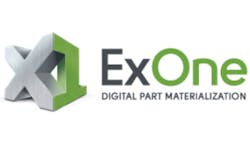The ExOne Company is adding phenolic and sodium-silicate binders to its offerings for 3D sand printing, and introducing a new metal alloy to its portfolio of 3D printing capabilities, “iron infiltrated with bronze.”
ExOne supplies 3D printing machines to industrial operations, and also produces 3D printed products for industrial customers. The company said adding more sand binders to its offerings would “develop its reach into the molds and casting industry.”
Hoosier Pattern in Decatur, IN, will begin operating an ExOne printer in August, and claims it will be the first commercial patternmaker in North America to offer 3D printed patterns, molds and cores.
ExOne noted that phenolic binders would make its 3D printing systems appealing to producers of molds and cores that use ceramic sands, which would include products high-value castings for automotive, aerospace, heavy equipment, and pump/valve OEMs.
Sodium-silicate binders, it added, would be attractive to foundries seeking to reduce casting emissions.
As for the new metal, ExOne explained that expanding its direct metal printing capabilities in industrial markets is part of its strategy for growth. “We are excited to add iron infiltrated with bronze to our product offerings,” stated chief technology officer Rick Lucas. “We continue to focus on the development of our other metals and materials.”
Reportedly, ExOne’s Material Applications Laboratory currently has 11 other materials in development.
Because iron components are widely used in machine tools, as automotive parts, and in “general support structures,” it forecast that producing iron-based products by 3D printing would allow those manufacturers to create more detailed designs for such parts.
ExOne said that it prioritized its development of iron infiltrated with bronze due to “general customer interest and the breadth of the manufacturing market.”
It added that the new material would be more cost-effective than other 3D printing materials, citing stainless steel, for example. Because ferrous alloys are frequently chosen for affordability, ExOne said it believes the new alloy would be well received by manufacturers that have selected iron for other products.
“We remain committed to releasing at least one new material every six months,” Lucas said. “Our priorities are defined by the needs of our current customers and as we uncover new opportunities with prospective customers.”
About the Author
Robert Brooks
Content Director
Robert Brooks has been a business-to-business reporter, writer, editor, and columnist for more than 20 years, specializing in the primary metal and basic manufacturing industries. His work has covered a wide range of topics, including process technology, resource development, material selection, product design, workforce development, and industrial market strategies, among others.
